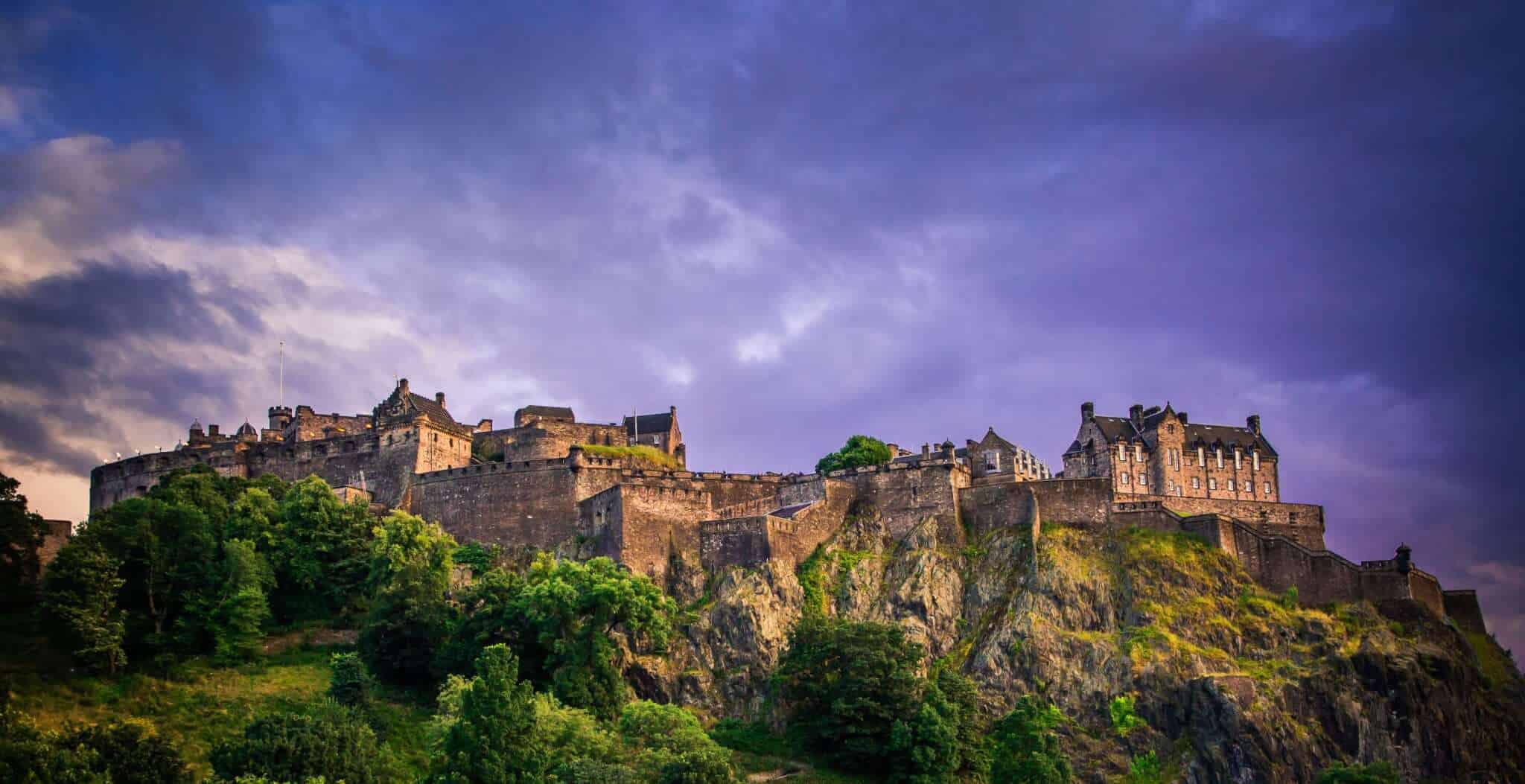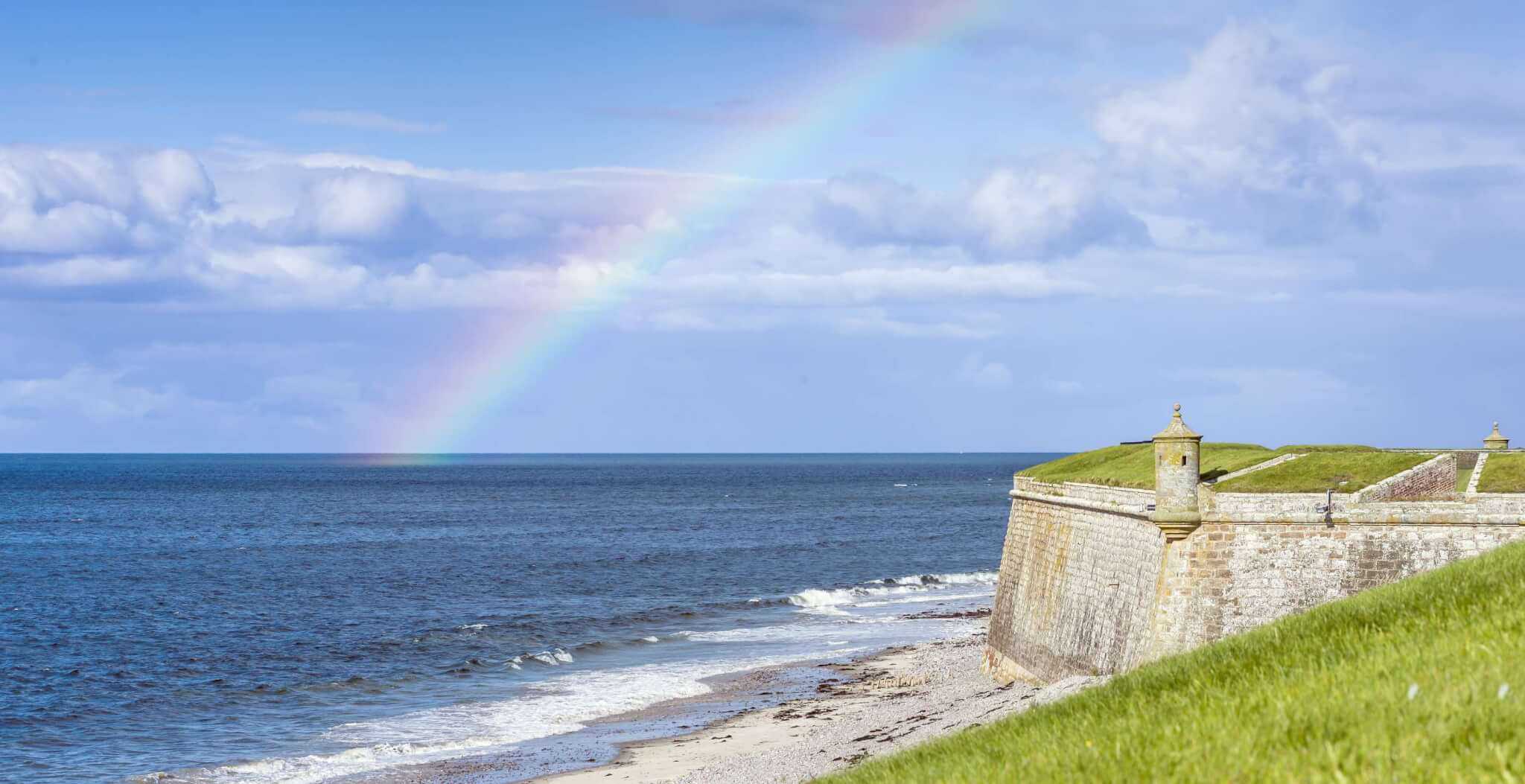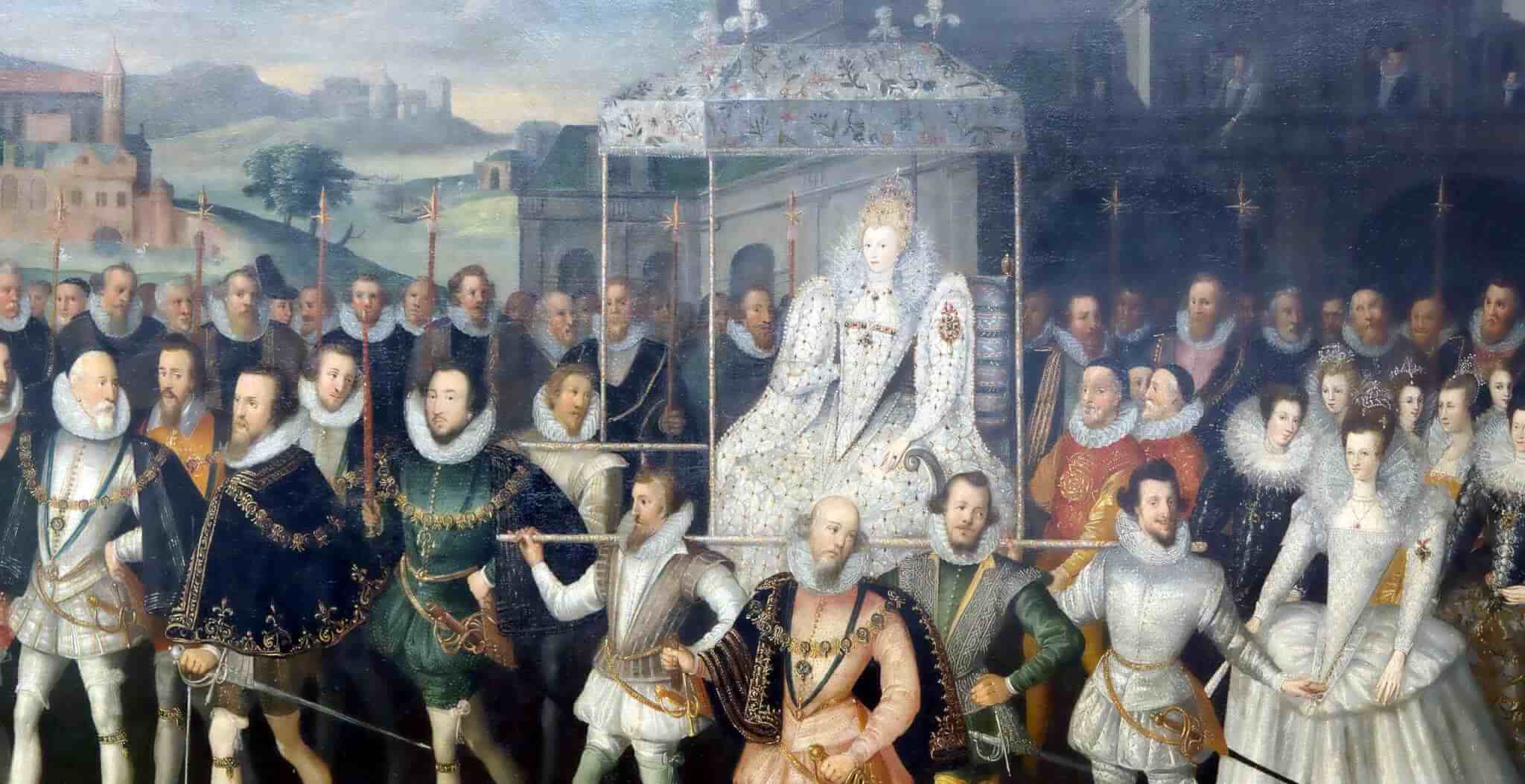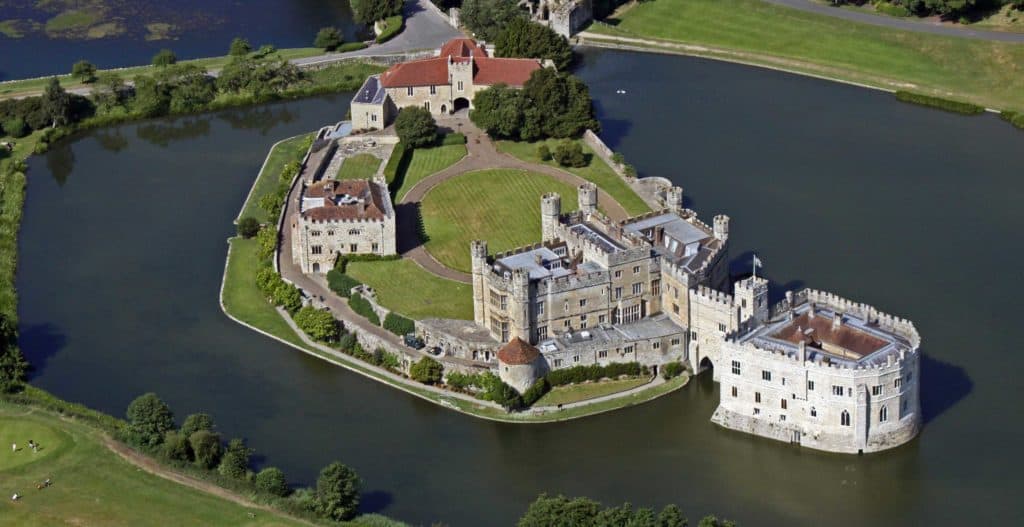Scotland is world famous for its castles, not just because so many are immaculately preserved but also because many are set against some of the most breathtaking scenery in Britain. From Muness, the most northerly castle in the United Kingdom on the Shetland Islands, to Edinburgh Castle with its fabulous Scottish Crown Jewels, we’ve scoured the country to bring you one of the most complete lists of castles in Scotland on the internet.
To get the most out of our interactive map, please select the ‘Satellite’ option below; which in our opinion, allows you to more fully appreciate the castle and its defences from above.
Oh, and if you are planning a trip to Scotland but are short on time, you may be interested to know that Aberdeenshire has more castles per hectare than anywhere else in the UK!
Looking to stay in one of these fabulous castles? We list some of the country's finest accommodation on our castle hotels in Scotland page.
Castles in Scotland
| Aberdour Castle, Aberdour, Fife Owned by: Historic Scotland One of Scotland's oldest castles. Venue for hire only. |
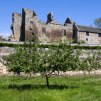 |
| Abergeldie Castle, Abergeldie, Grampian Owned by: Gordon family 16th century tower house. |
|
| Ardvreck Castle, Inchnadamph, Highlands Owned by: Scheduled Ancient Monument Remains of 16th century castle thought to have been constructed by the Clan MacLeod. Free and open access at any reasonable time. |
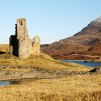 |
| Auchindoun Castle, Dufftown, Moray, Grampian Owned by: Historic Scotland Remains of 15th century tower castle within the earthworks of an Iron Age hillfort, believed to have been built by Thomas Cochrane. Free and open access at any reasonable time. |
|
| Balmoral Castle, Aberdeenshire Owned by: British Royal Family Scottish residence of the British Royal Family. Although the original Balmoral Castle dated from the 15th century, this building was considered too small when Queen Victoria and Prince Albert fell in love with the region and people during a visit to the Scottish Highlands. Prince Albert set about organising the design of the current castle and grounds when the Royal Family purchased the estate in 1852. Construction of the new castle started during the summer 0f 1853, on a site just 100 yards from the original building. The new royal residence was completed in 1856, and the old castle was demolished. The couple spent many weeks each year relaxing at their new home in Highlands, and after Albert's death, Victoria spent up to 4 months each year at Balmoral. Restricted opening times and entrance charges apply. |
|
| Balvaird Castle, Newton of Balcanquhal, Perthshire Owned by: Historic Scotland Complete example of a traditional late medieval Scottish tower house. Free and open access at any reasonable time to site; limited access to tower house. |
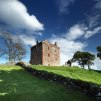 |
| Balvenie Castle, Dufftown, Moray, Grampian Owned by: Historic Scotland Remains of 12th century castle with massive curtain wall, seat of the Black Comyns. Restricted opening times and entrance charges apply. |
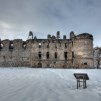 |
| Beldorney Castle, Dumeath, Aberdeenshire, Grampian Owned by: Robinson family Restored 16th century tower house, probably built by George Gordon, the first Laird of Beldorney. Only occasionally open to the public, as privately owned. |
|
| Blackness Castle, Blackness, Linlithgow, Lothian Owned by: Historic Scotland Well preserved 15th-century fortress on the south shore of the Firth of Forth. Restricted opening times and entrance charges apply. |
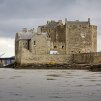 |
| Blair Castle, Perthshire Owned by: Duke of Atholl Complete medieval castle, remodelled in a Scottish Baronial style in the 19th century. Commanding a strategic position on the main route through the central Scottish Highland, Blair Castle is said to have been started by John Comyn, Lord of Badenoch, around 1269. In the centuries that followed, the castle changed hands several times until 1629, when it became the seat of the Clan Murray. As supporters of the Royalist cause, the castle was attacked and taken by Oliver Cromwell's Parliamentarian Army in 1650. Attacked and besieged again during the Jacobite rising of 1745, the starving defenders were only relieved when the Jacobite forces withdrew to fight British Government forces at the Batlle of Culloden. Restricted opening times and entrance charges apply. |
|
| Borve Castle, Benbecula, Western Isles, Highlands Owned by: Scheduled Ancient Monument Ruins of late 14th century tower house, occupied by the Macdonalds of Benbecula until the early 17th century. Free and open access at any reasonable time. |
|
| Bothwell Castle, Uddingston, Strathclyde Owned by: Historic Scotland Impressive remains of large medieval castle. One of Scotland's largest and finest 13th century castles, set on a high steep bank commanding the River Clyde. Restricted opening times and entrance charges apply. |
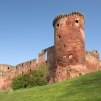 |
| Braemar Castle, Aberdeenshire Owned by: Clan Farquharson Largely restored 17th century castle. Originally built in 1628 by John Erskine, Earl of Mar, as a hunting lodge, the castle was attacked and burned by John Farquharson, the Black Colonel of Inverey in 1689. Following the quashing of the Jacobite Rebellion at the Battle of Culloden in 1746, the castle was rebuilt and became a garrison for Hanovarian troops. When government forces were withdrawn in 1831, the castle was returned to the Farquharson clan. Restricted opening times and entrance charges apply. |
|
| Brodie Castle, Moray Owned by: National Trust for Scotland Well preserved 16th century castle keep. Built in 1567 by the Clan Brodie, the castle was destroyed by fire in 1645 by members of the Clan Gordon during the Scottish Civil War. It was expanded into a mansion house in the Scots Baronial style in 1824 and continued as the Brodie family home until Ninian Brodie of Brodie died in 2003. Restricted opening times and entrance charges apply. |
|
| Broughty Castle, Broughty Ferry, Angus Owned by: Historic Scotland Intact late 15th century coastal defensive castle, built in response to increased English naval activity in the area. The castle now houses a museum, with restricted opening times and entrance charges. |
|
| Burleigh Castle, Milnaththort, Perthshire Owned by: Historic Scotland Almost complete late 15th century tower house, extended in the 16th century with the addition of a curtain wall and tower. Free and open access at any reasonable time. |
|
| Cadzow Castle, Chatelherault Country Park, Hamilton, Strathclyde Owned by: Historic Scotland Remains of 16th century castle where Mary, Queen of Scots stayed following her escape from Loch Leven Castle in 1568. In the grounds of Chatelherault Country Park, with free and open access at any reasonable time. |
|
| Caerlaverock Castle, Glencaple, Dumfries and Galloway Owned by: Historic Scotland Impressive and well preserved moated triangular castle, built in the 13th century. Due to its border location, Caerlaverock was besieged several times by the English. Restricted opening times and entrance charges apply. |
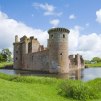 |
| Cairnbulg Castle, Fraserburgh, Aberdeenshire, Grampian Owned by: Fraser family Intact 13th century fortified tower house, built at a time when this area of north east Scotland was under constant threat from Viking attack. Now a private home and not generally open to visitors. |
|
| Caisteal Bheagram, Drimsdale, South Uist, Western Isles Owned by: Scheduled Ancient Monument Remains of small fortified tower, dating from the late 15th century. A small fortified tower built by Clanranald on a small island in the centre of Loch an Eilean. Dating from around 1600, the two-storey tower was connected by a causeway to the southern bank of the loch. Free and open access at any reasonable time. |
|
| Cardoness Castle, Gatehouse of Fleet, Dumfries and Galloway Owned by: Historic Scotland Substantial remains of 15th century six-storey tower house with commanding views over Fleet Bay. Restricted opening times and entrance charges apply. |
|
| Carnasserie Castle, Kilmartin, Strathclyde Owned by: Historic Scotland Remains of 16th century tower house and hall, built by reforming churchman John Carswell, Rector of Kilmartin. Free and open access at any reasonable time. |
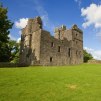 |
| Carsluith Castle, Creetown, Dumfries and Galloway Owned by: Historic Scotland Remains of lightly defended 16th century tower house; the lairds of Carsluith at the time were members of the Cairns family. Free and open access at any reasonable time. |
|
| Castle Campbell, Dollar, Stirlingshire Owned by: Historic Scotland Imposing remains of 15th century tower house with later additions. Originally the property of the Clan Stuart, it passed by marriage to Colin Campbell, who had the name changed to Castle Campbell by an Act of Parliament in 1489. Restricted opening times and entrance charges apply. |
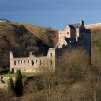 |
| Castle Fraser, Aberdeenshire Owned by: National Trust for Scotland One of the grandest of the Scottish baronial tower houses. Started in 1575 by the 6th Laird of Fraser, the castle was completed in 1636. The ancestral home of the Fraser family, it was modernised in a classic style in the late 18th century and today stands as one of the grandest Castles of Mar. Restricted opening times and entrance charges apply. |
|
| Castle Menzies, Perthshire Owned by: Menzies Charitable Trust Intact 16th century Scottish castle. The seat of the Chiefs of Clan Menzies for over 400 years, this 16th century fortified house was formerly known as Weem Castle. Bonnie Prince Charlie rested at the castle on his way to the Battle of Culloden in 1746. Just four days later it was garrisoned by the Duke of Cumberland, son of the British monarch and commander of the victorious Government forces. Restricted opening times and entrance charges apply. |
|
| Castle of Old Wick, Wick, Highlands Owned by: Historic Scotland Remains of 12th century Norse castle, possibly built by the great Earl Harald Maddadson, half-Orcadian and half-Scottish, who was at that time the sole earl of Orkney and Caithness. One of the oldest castles in Scotland, it was built at a time when the kings of Norway ruled this area of the Scottish mainland as well as the Northern and Western Isles. Free and open access at any reasonable time. |
|
| Castle Stalker, Portnacroish, Strathclyde Owned by: Allward family Well preserved remains of 14th century four-storey tower house, or keep, set on a tidal islet on Loch Laich. King James IV frequently stayed at the castle on his hunting and hawking trips to the area. A privately owned castle with limited tours by arrangement. |
 |
| Castle Sween, Lochgilphead, Argyll and Bute Owned by: Historic Scotland Remains of 12th century castle, one of the earliest stone castles built in Scotland. Built by the Clan Suibhne (pronounced Sween), the castle changed hands many times during the medieval period. Free and open access at any reasonable time. |
|
| Castle Tioram, Moidart, Highlands Owned by: Anta Estates A ruined 14th century castle that sits on the tidal island of Eilean Tioram in Loch Moidart. The seat of Clanranald, part of the MacDonald clan, Tioram was an important power base in medieval times. Now in a poor state of repair and currently closed to the public for safety reasons. |
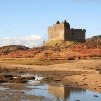 |
| Cawdor Castle, Highlands Owned by: Cawdor family Intact 15th century tower house with later additions. Built around a 15th century tower house or keep, the current castle has evolved over 600 years with substantial additions from the 17th century. The medieval tower was built as a private fortress by William Calder, 6th Thane of Cawdor (orig. Calder) in 1454. Although Shakespeare's Macbeth is titled Thane of Cawdor, the current castle was built centuries after the life of the 11th century King Macbeth. Restricted summer opening times and entrance charges apply. |
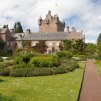 |
| Claypotts Castle, Broughty Ferry, Angus Owned by: Historic Scotland Intact 16th century Scottish tower house, originally built by John Strachan between 1569 and 1588 and later owned by 'Bonnie Dundee', John Graham of Claverhouse. Usually free and open access at any reasonable time, external viewing only. |
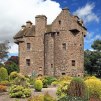 |
| Corgarff Castle, Corgarff, Aberdeenshire, Grampian Owned by: Historic Scotland Medieval tower house, built in the mid-16th century by John Forbes of Towie. The Forbes clan maintained a long and bloody feud with Clan Gordon, which in November 1571 culminated in the Congarff Massacre. With their menfolk away, the castle was torched by members of Clan Gordon; as a result 24 Forbes women and children perished. Restricted opening times and entrance charges apply. |
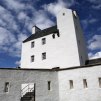 |
| Coulter Motte, Wolfclyde, Lanarkshire, Strathclyde Owned by: Historic Scotland Earthwork remains of 12th century Norman motte, common to this area after Malcolm IV granted land in Clydesdale to Flemish newcomers. Usually free and open access at any reasonable time. |
|
| Craigievar Castle, Alford, Grampian Owned by: National Trust for Scotland Intact 17th century Scottish Baronial castle. Completed in 1626 by the Aberdonian merchant William Forbes, brother of the Bishop of Aberdeen, this great seven-storey castle is an excellent example of Scottish Baronial architecture. Restricted opening times and entrance charges apply. |
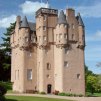 |
| Craigmillar Castle, Edinburgh, Lothian Owned by: Historic Scotland Remains of medieval castle. Begun in the late 14th century by the Preston family and extended throughout the 15th and 16th centuries. Mary, Queen of Scots Mary visited Craigmillar in November 1566 to convalesce following the birth of her son, the future James I of England. Restricted opening times and entrance charges apply. |
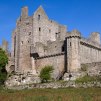 |
| Craignethan Castle, Crossford, Lanarkshire, Strathclyde Owned by: Historic Scotland Remains of early 16th century artillery fortification. Possibly the last great private military castle to be built in Scotland, Craignethan is a fine example of an early artillery fortress. Built in the first half of the 16th century, it is based around a tower house built by Sir James Hamilton of Finnart. Restricted opening times and entrance charges apply. |
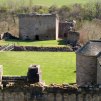 |
| Crathes Castle, Aberdeenshire Owned by: National Trust for Scotland Intact and well preserved 16th century Scottish castle. Started in 1553, construction was delayed due to political issues surrounding the reign of Mary, Queen of Scots, and the castle was not completed until 1596. Crathes served as the ancestral seat of the Burnetts of Ley for over 350 years, until gifted to the NTS in 1951. Restricted opening times and entrance charges apply. |
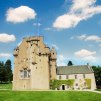 |
| Crichton Castle, Crichton, Lothian Owned by: Historic Scotland Remains of late 14th century tower house. Originally built as a tower house in the late 14th century by John de Crichton as his family residence, it later became home to the Earls of Bothwell who added the stunning 16th century courtyard facade. Restricted opening times and entrance charges apply. |
|
| Crookston Castle, Pollok, Strathclyde Owned by: Historic Scotland Remains of 15th-century castle set within 12th-century earthworks. Built on a much earlier fortified site, this new massive tower house was started around 1390. This unusual property consists of a central tower with four square corner towers, set within 12th-century earthworks. Usually free and open access at any reasonable time. |
|
| Cubbie Row's Castle, Wyre, Orkney Owned by: Historic Scotland Remains of early stone Norse castle. One of the earliest stone castles in Scotland, built around 1145 by the Norseman Kolbein Hruga, the site includes a small rectangular tower enclosed within a circular ditch. A ruined chapel dating from the late 12th century also occupies the site, which is located on the island of Wyre and can be reached using Orkney Ferries Ltd from Kirkwall. Usually free and open access at any reasonable time. |
|
| Culzean Castle, Ayrshire Owned by: National Trust for Scotland Refurbished 18th century castle. Built between 1777 and 1792, Culzean is the former home of the Marquess of Ailsa, the chief of the Clan Kennedy. In 1945 the family gifted the castle to the NTS. A condition of the gift stipulated that the top floor apartment was made available to General Dwight D Eisenhower, in recognition of his role during World War Two. The general stayed at Culzean on four occasions, including once when President of the United States. Restricted opening times and entrance charges apply. |
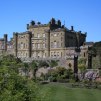 |
| Delgatie Castle, Turriff, Aberdeenshire, Grampian Owned by: Delgatie Castle Trust This 11th century fortress has been home to the Hay Clan for the last 650 years. The earliest castle at Delgatie dates from around 1030, with much of the current structure the result of rebuilding in the late 16th century and mid-18th century. Mary, Queen of Scots stayed in the castle for three days in 1562 following the Battle of Corrichie. Now open to the public and offering self-catering accommodation sleeping up to 5 people in the elegant Symbister Suite, located in the north wing of the castle. |
|
| Dirleton Castle, Dirleton, Lothian Owned by: Historic Scotland Remains of medieval fortress. Started around 1240 by John De Vaux, this substantial fortresses residence was badly damaged during the Wars of Scottish Independence, when it was twice taken by the English. Rebuilt and reinforced, the castle was again damaged during Cromwell's siege of 1650; it was then left to decay. Its fortunes were revived in the 1660s when the Nisbet family built a new mansion close to the picturesque ruins. Restricted opening times and entrance charges apply. |
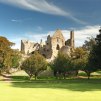 |
| Doune Castle, Doune, Stirling Owned by: Historic Scotland Remains of late 14th century courtyard castle. Originally built in the 13th century, it was damaged during the Scottish Wars of Independence before being rebuilt in the late 14th century by Robert Stewart, the son of King Robert II of Scotland. Restricted opening times and entrance charges apply. |
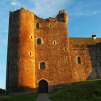 |
| Druchtag Motte, Mochrum, Dumfries and Galloway Owned by: Historic Scotland Earthwork remains of 12th century Norman motte, common to this area and one of over sixty similar mottes throughout Dumfries and Galloway. It appears that the wooden fortification that stood atop was never converted to a stone one, as many Norman castles were. Usually free and open access at any reasonable time. |
|
| Drum Castle, Aberdeenshire Owned by: National Trust for Scotland Intact 13th century square tower and Jacobean mansion. One of the oldest tower houses in Scotland, the castle and grounds were granted to William de Irwyn by Robert the Bruce in 1325. The original tower was transformed in 1619 when the then laird, Alexander Irvine added the Jacobean mansion. The castle was attacked and occupied several times during the Civil Wars of the 1600's. Despite backing the losing side in both Jacobite uprisings, Drum remained the seat of the chief of the Clan Irvine until 1975. Restricted opening times and entrance charges apply. |
|
| Drumcoltran Tower, Dalbeattie, Dumfries and Galloway Owned by: Historic Scotland Well preserved late 16th century tower house, still standing three storeys high. Usually free and open access at any reasonable time. |
|
| Drumin Castle, Glenlivet, Moray, Grampian Owned by: Scheduled Ancient Monument Remains of 14th century tower house, once home to King Robert II's son, Alexander Stewart, aka the 'Wolf of Badenoch', who was noted for his mild temper and sense of justice, and best remembered for the sacking and burning of Elgin Cathedral in 1390 as part of his long term feud with the Bishop of Moray. The castle was abandoned in the 18th century and fell into disrepair. Usually free and open access at any reasonable time. |
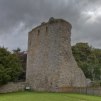 |
| Duart Castle, Isle of Mull Owned by: Sir Lachlan Maclean Largely restored 13th century castle. As featured in the Disney movie 'Brave', this 13th century castle occupies one of the most spectacular sites in Scotland. Set high on a rocky crag jutting out into the Sound of Mull, in 1350 Duart was gifted to Lachlan Maclean as a dowry when he married Mary Macdonald, the daughter of the Lord of the Isles. The ancestral home of the Clan Maclean, in 1691 the castle surrendered to the government forces of the Duke of Argyll. By 1751 the castle had been abandoned and remained in a ruinous state until 1910, when it was purchased by Sir Fitzroy Maclean, the 26th chief, who began the task of restoring it to its present condition. Restricted opening times and entrance charges apply. |
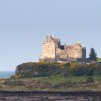 |
| Duffus Castle, Duffus, Moray, Grampian Owned by: Historic Scotland The original Norman motte and bailey fortress comprised an impressive earthwork mound surrounded by a timber palisade; the wooden keep was later rebuilt in stone. The castle was built around 1150 by a Flemish knight named Freskin de Moravia, the name was later adapted into the more familiar Moray. Usually free and open access at any reasonable time. |
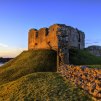 |
| Dumbarton Castle, Dumbarton, Strathclyde Owned by: Historic Scotland Mainly 18th century artillery fortifications. Impressively set on a volcanic rock overlooking the Firth of Clyde, Dumbarton was the centre of the ancient kingdom of Strathclyde from the 5th century. Most of the existing structures however, date from the 18th century with substantial new artillery fortifications. Restricted opening times and entrance charges apply. |
|
| Dundonald Castle, Dundonald, Ayrshire Owned by: Historic Scotland Remains of imposing royal castle dating from 14th century. This imposing medieval castle was built by Robert II in the 1371 to mark his succession to the throne of Scotland and was used as a royal residence by the early Stewart kings for the next 150 years. Restricted summer opening times and entrance charges apply, details from the visitor centre and museum. |
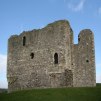 |
| Dunnideer Castle, Insch, Aberdeenshire, Grampian Owned by: Scheduled Ancient Monument The ruins of a 13th century castle set within the ramparts of an Iron Age hillfort that shows evidence of burning. The earthen defences are easily visible and comprise a series of high banks and ditches. The medieval stone tower is built using stones from the vitrified fort. Usually free and open access at any reasonable time. |
|
| Dunnottar Castle, Nr Stonehaven, Grampian Owned by: Dunecht Estates Remains of medieval fortress from of the 15th and 16th centuries. The surviving buildings of this impressive ruined medieval fortress date mainly from the 15th and 16th centuries; however the site is believed to have been fortified from the early Middle Ages. Due to its strategic location, Dunnottar has played a prominent role throughout Scotland's history, but is perhaps best known as the place where the Honours of Scotland, the Scottish crown jewels, were hidden from Oliver Cromwell's invading army during the 17th century. Restricted opening times and entrance charges apply. |
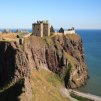 |
| Dunskey Castle, Portpatrick, Dumfries and Galloway Owned by: Scheduled Ancient Monument Remains of 16th century tower house on the site of a 14th century castle. Although the site appears to have been fortified since the Iron Age, the current tower house was built after the medieval castle burned down in the early 16th century following a local skirmish. Standing high at the head of a rocky promontory, the new castle was not occupied for long, being described as ruinous as early as 1684. Usually free and open access at any reasonable time. |
|
| Dunrobin Castle, Highlands Owned by: Lord Strathnaver Intact Scottish Baronial style castle, encompassing earlier fortifications. The ancient seat of the Clan Sutherland, the lands of Sutherland were first acquired by Hugh, Lord of Duffus around 1211. The first mention of a castle on the site dates from 1401, a square keep set atop a cliff surrounded by a curtain wall. One of the most powerful families in Scotland, the Earldom of Sutherland was created in 1235. Besieged twice in 1518, the castle was also stormed during the Jacobite Rising of 1745, as the Clan Sutherland supported the British government. The early castle was extended and remodelled from the 16th century onwards, and was finally transformed from defensive structure into a house in the Scottish Baronial style in 1845. Restricted opening times and entrance charges apply. |
|
| Dunstaffnage Castle, Oban, Argyll and Bute, Strathclyde Owned by: Historic Scotland Partially ruined 13th century castle. On a huge rock overlooking the Firth of Lorn, the castle was built as the stronghold of the Clan MacDougall. One of Scotland's oldest stone castles with a huge curtain wall, it was captured by Robert the Bruce in 1309 and remained in royal possession for some years after. In 1746 Dunstaffnage became the temporary prison of Flora MacDonald. Restricted opening times and entrance charges apply. |
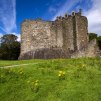 |
| Duntulm Castle, Isle of Skye Owned by: Scheduled Ancient Monument Remains of 14th and 15th century castle. Set on a sheer cliff with views across to the Isle of Lewis, Duntulm was built between the 14th and 15th centuries, at a time of great feuding between the rival clans of Macleod and Macdonald. By the early 17th century the Macdonalds had established supremacy in the area and the castle was extended. Duntulm was finally abandoned when the clan chief Sir Alexander Macdonald built a new home a few miles to the south. Usually free and open access at any reasonable time. |
 |
| Dunvegan Castle, Isle of Skye Owned by: The Clan MacLeod Beginning its life in the 1200's as a simple masonry wall surrounding a former Norse fort, most of the current Dunvegan Castle was constructed in the mid 14th century by Malcolm MacLeod and has been home of the Clan MacLeod ever since. Dunvegan is famous for being the oldest continuously inhabited castle in Scotland. |
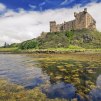 |
| Edinburgh Castle, Edinburgh, Lothian Owned by: Scottish Government The most important royal fortress in the Kingdom of Scotland. Although the site has been occupied since 900BC, the current royal castle dates from the reign of King David I in the 12th century. The castle continued in use as a royal residence until the Union of the Crowns in 1603. As the most important fortress in the Kingdom of Scotland, Edinburgh has been involved in many conflicts through the ages, from the Wars of Scottish Independence in the 14th century to the Jacobite Rising of 1745. Today, the castle is the setting for Edinburgh's famous military tattoo and houses the Honours of Scotland, the Scottish National War Memorial, the Stone of Destiny and is Scotland's most visited tourist attraction. Restricted opening times and entrance charges apply. |
 |
| Edzell Castle, Edzell, Angus Owned by: Historic Scotland Remains of late medieval tower house with 17th century walled garden. Started around 1520 by David Lindsay, 9th Earl of Crawford, the castle was expanded by his son. More of a country house than a defensive structure, it was briefly occupied by English troops during Oliver Cromwell's invasion of Scotland in 1651. Today, the castle consists of the remains of the original tower house with an adjacent Renaissance walled garden. Restricted opening times and entrance charges apply. |
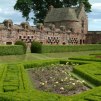 |
| Eilean Donan Castle, Dornie, Kyle of Lochalsh, Highlands Owned by: Conchra Charitable Trust Spectacularly sited reconstructed Medieval castle. Sited on an island, connected by a causeway to the mainland at the head of Loch Duich, the first fortified castle was constructed in the mid-13th century and stood guard over the lands of Kintail. Built and re-built over the centuries following various raids and sieges, the castle was partially destroyed in a Jacobite uprising in 1719. Eilean Donan lay in ruins until being authentically reconstructed to its medieval state in the mid 1900s by Lieutenant Colonel John MacRae-Gilstrap. Restricted opening times and entrance charges apply. |
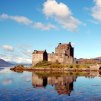 |
| Elcho Castle, Elcho, Perthshire, Tayside Owned by: Historic Scotland Almost complete, this 16th century fortified mansion is located just a short distance from the south bank of the River Tay. Built on the site of an earlier structure, the tower house was started around 1560 and remains one of the best surviving examples of its type in Scotland. Restricted opening times and entrance charges apply. |
|
| Fast Castle, Coldingham, Borders Owned by: Scheduled Ancient Monument Dramatically sited remains of medieval fortress. Situated on a dramatic rocky promontory, the current castle predates 1346, when documents suggest that it was occupied by English troops following the Battle of Neville's Cross. In 1503 Margaret Tudor, daughter of the English King Henry VII, stayed overnight at the castle on her way to Edinburgh for her marriage with James IV of Scotland. Destroyed in 1515 and rebuilt again in 1521, the castle changed hands several times through the rest of the 16th century. It fell into disrepair shortly after this. Usually free and open access at any reasonable time. |
|
| Fa'side Castle, East Lothian Owned by: Historic Scotland Intact 15th century keep. Also known as Fawside and Faside, the Fawsyde family acquired the land in 1371 and began building the castle in the 15th century. Burned by the English in 1547, Mary, Queens of Scots stayed at Fa'side before the Battle of Carberry Hill in June 1567. Now under private ownership with restricted access. |
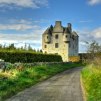 |
| Findlater Castle, Cullen, Aberdeenshire, Grampian Owned by: Scheduled Ancient Monument Dramatically sited remains of medieval castle. Overlooking the Moray Firth, the first reference to the castle dates from 1246. Later in the 1260s King Alexander III of Scotland readied the castle for an invasion by King Haakon IV of Norway. Although Vikings occupied the castle for a period, the current remains date from the 14th century when it was remodelled and rebuilt. Usually free and open access at any reasonable time. |
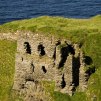 |
| Fyvie Castle, Turriff, Inverurie, Aberdeenshire, Grampian Owned by: National Trust for Scotland Intact and impressive Scottish baronial castle with Edwardian interiors. Although the earliest parts of the castle date from the 13th century, each of five successive family owners - Preston, Meldrum, Seton, Gordon and Leith - contributed a new tower. The earliest of these, the Preston tower, dates from around 1400 whilst the Leith tower was added as late as 1890. The Edwardian interiors contain a superb collection of arms and paintings. Restricted opening times and entrance charges apply. |
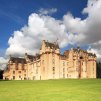 |
| Glamis Castle, Angus Owned by: Earl of Strathmore Intact 17th century castle, childhood home of the late HM Queen Elizabeth, The Queen Mother. Glamis has been the home of the Lyon family since the 14th century. Originally a royal hunting lodge, in 1034 King Malcolm II of Scotland was murdered at Glamis. The first castle was built at Glamis by Sir John Lyon around 1376; the present structure however dates mainly from the 17th century. Although Shakespeare mentions Glamis as the home as Macbeth, there is no evidence to link the king with the castle. Restricted opening times and entrance charges apply. |
|
| Glenbuchat Castle, Glenkindie, Aberdeenshire, Grampian Owned by: Historic Scotland Well preserved remains of 16th century tower house. Set above the River Don, this tower house was built in 1590 for John Gordon of Cairnbarrow to mark his wedding to Helen Carnegie. The family sold the castle in 1738 after which it fell into disrepair, and by the Victorian period it was roofless. Usually free and open access at any reasonable time. |
|
| Greenknowe Tower, Gordon, Borders Owned by: Historic Scotland Remains of 16th century tower house. Built in 1581 by James Seton, the tower stands on a natural mound, which was defended by low lying marshy ground. In the 17th century, the castle was sold to the Pringles of Stichill who modernised the building to suit the less dangerous times. The castle remained occupied until the mid-19th century. Usually free and open access at any reasonable time. |
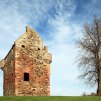 |
| Gylen Castle, near Oban Owned by: Scheduled Ancient Monument Remains of 16th century castle. Dramatically set high on a rocky outcrop overlooking the Firth of Lorne, Gylen was built in 1582 by the Clan MacDougall. Located on the southern part of the island, the castle was in use for only a short period as it was besieged and destroyed by the Covenanters in 1647, during the Wars of the Three Kingdoms. Usually free and open access at any reasonable time. |
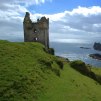 |
| Hailes Castle, East Linton, Lothian Owned by: Historic Scotland Substantial remains of a 13th century fortified manor house, extended in the 14th and 15th centuries. Enjoying a fine riverside setting, the castle was originally constructed as a fortified tower house by Hugo de Gourlay sometime before 1300, making it one of the oldest stone structures of its type in Scotland. Usually free and open access at any reasonable time. |
|
| Hermitage Castle, Liddesdale, Borders Owned by: Historic Scotland Semi-ruined substantial 14th and 15th century fortress. With a reputation, both from its history and its appearance, as one of the most sinister and atmospheric castles in Scotland, this substantial 14th and 15th century ruin was once known as the guardhouse of the bloodiest valley in Britain. Mary, Queen of Scots made a famous marathon journey to visit the wounded Bothwell at Hermitage, only a few weeks after the birth of her son. Restricted opening times and entrance charges apply. |
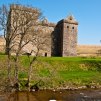 |
| Huntingtower Castle, Perth, Tayside Owned by: Historic Scotland Remains of two complete tower houses. Once known as The House of Ruthven, Huntingtower Castle comprises two complete tower houses, one 15th century, the other 16th century; both towers are connected by a 17th century range. Restricted opening times and entrance charges apply. |
|
| Huntly Castle, Huntly, Aberdeenshire, Grampian Owned by: Historic Scotland Remains of medieval castle. Strategically sited at the confluence of the rivers Bogie and Deveron, the castle was gifted to Sir Adam Gordon by King Robert I (the Bruce), as reward for his faithful service. With the majority of the Clan Gordon away on the king's business, the castle was razed to the ground in 1452 by forces of the powerful Black Douglases. A grander castle quickly replaced the burnt out remains, which was again extensively remodelled it in the 1550s by George 'Cock o' the North' Gordon. It was the Civil War that brought an end to the Gordon family's long occupation of the castle; they again sided with the king! Restricted opening times and entrance charges apply. |
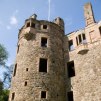 |
| Inverness Castle, Highlands Owned by: Scottish government Intact 19th century neo-Norman structure. Although a succession of castles has stood on this site since 1057, the current red sandstone structure was built in 1836, and now houses the Sheriff Court. The castle is not open to the public; however the grounds are freely accessible. |
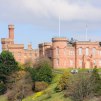 |
| Inverlochy Old Castle, Fort William, Highlands Owned by: Historic Scotland Remains of 13th century castle. Built around 1275 by John the Black Comyn, chief of the Clan Comyn. When Robert the Bruce succeeded to the Scottish throne in 1306, the Comyns, his rivals for the crown, were dispossessed and the castle was left unoccupied for a short period. The site of two battles, the castle remains largely unchanged since its construction and is one of Scotland's oldest stone fortresses. Usually free and open access at any reasonable time. |
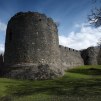 |
| Inverurie Bass, Inverurie, Aberdeenshire, Grampian Owned by: Scheduled Ancient Monument This 12th century Norman motte and bailey fortification, standing within a later burial ground beside the confluence of the Rivers Don and Uri, is one of only a handful to be found in north east Scotland. Usually free and open access at any reasonable time. |
|
| Kilchurn Castle, Loch Awe, Dalmally, Argyll and Bute Owned by: Historic Scotland Remains of 15th - 17th century castle. The ancestral home of the Campbells of Glen Orchy, Kilchurn was built in about 1450 as a five storey tower house with an outer wall. Further buildings were added during the 16th and 17th centuries. Set on a small island in Loch Awe, the castle would have been accessed by a low-lying causeway. Usually free and open access at any reasonable time during summer months. |
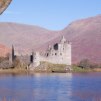 |
| Kildrummy Castle, Alford, Aberdeenshire, Grampian Owned by: Historic Scotland Remains of extensive 13th century castle. The stronghold of the Earls of Mar, Kildrummy was built in the mid-13th century and endured numerous sieges through the ages. The first in 1306 led to the capture of Robert the Bruce's wife and daughter. The 12 year old Lady Marjorie was imprisoned in the Tower of London, locked in a cage and forbidden to speak. Although held as a royal castle for a brief period, the castle was abandoned in 1716 following the failure of the Jacobite rebellion. Now ruined, it remains a fine example of a 13th century castle with its curtain wall, four round towers, hall and chapel. Restricted summer opening times and entrance charges apply. |
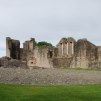 |
| Kinnairdy Castle, Aberchirder, Grampian Owned by: Innes family Intact medieval castle and 15th century tower house, originally built as a motte and bailey fortification with a stone keep atop the motte. A six storey tower was added early in 15th century and sometime after 1500 the east wing was added. Around 1725 the top two storeys of the tower were removed to give the castle its current look. Privately owned, it is not normally open to the public. |
|
| Kisimul Castle, Castlebay, Barra, Western Isles Owned by: Historic Scotland This small medieval castle stands in the centre of Castlebay on Barra, an island in the Outer Hebrides. The earliest mention of Kisimul dates from the mid-16th century. The castle takes its name from the Gaelic ciosamul, or 'castle island'. Seat of the Chiefs of Clan Macneil. Restricted summer opening times and entrance charges apply. |
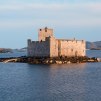 |
| Lauriston Castle, Edinburgh Owned by: City of Edinburgh Intact 16th century tower house. Overlooking the Firth of Forth, a castle has stood on this site since medieval times. The current tower house was built around 1590 by Sir Archibald Napier, master of the Scottish mint. Lauriston was extended in the Jacobean style by Thomas Allan in 1827. The grounds now operate as a local park, with restricted summer opening times and entrance charges to the castle. |
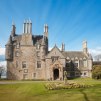 |
| Lews Castle, Isle of Lewis Owned by: Comhairle nan Eilean Siar Intact Victorian era castle. Having purchased the whole island a few years earlier with his fortune gained from the Chinese opium trade, Sir James Matheson had this Victorian-era castle built between 1847-57 as his new island residence. The industrialist Lord Leverhulme bought the estate in 1918 and gifted the castle to the people of Stornoway in 1923. The castle is currently undergoing refurbishment, and is due to re-open as a museum and cultural centre shortly. |
|
| Linlithgow Palace, Linlithgow, Lothian Owned by: Historic Scotland One of the principal residences of the Stewart kings and queens throughout the 15th and 16th centuries; both James V and Mary Queen of Scots were born at Linlithgow. Once Scotland's monarchs left for England in 1603, the palace was little used and was burned out in 1746. Restricted opening times and entrance charges apply. |
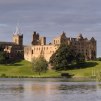 |
| Loch Doon Castle, Craigmalloch, Ayrshire, Strathclyde Owned by: Historic Scotland Remains of a transplanted 13th century castle. Originally located on an island within Loch Doon, this 13th century castle was dismantled and rebuilt on the side of the loch after the water level was raised in the 1930s for a hydroelectric scheme. The castle consists of an eleven-sided curtain wall of substantial height. Usually free and open access at any reasonable time. |
|
| Lochleven Castle, Kinross, Tayside Owned by: Historic Scotland Remains of medieval castle on an island. Built around 1250 on an island in Loch Leven, the castle occupies a strategically important position between Edinburgh, Stirling and Perth. Heavily involved in the Wars of Scottish Indepence, the castle was besieged and fought over several times between 1296 and 1357. Mary Queen of Scots was imprisoned at the castle between 1567 and 1568. During this time she was forced to abdicate as queen in favour of her son James. With the help of her gaoler, William Douglas, Mary escaped and fled to nearby Niddy Castle. Loch Leven is just one of many castles said to be haunted by Mary's spirit. With restricted summer opening times, the castle is accessible by ferry, entrance charges apply. |
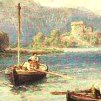 |
| Lochmaben Castle, Lochmaben, Dumfries and Galloway Owned by: Historic Scotland Originally built by the English in the 14th century, the castle was extensively rebuilt around 1500 during the reign of James IV. Lochmaben was largely dismantled after it's capture by James VI in 1588. The extensive earthworks built by Edward I of England are clearly visible surrounding the castle remains. Usually free and open access at any reasonable time. |
|
| Lochranza Castle, Lochranza, Isle of Arran, Ayrshire Owned by: Historic Scotland Remains of 12th century tower house with later additions. Standing on a narrow stretch of land on the southern shore of Loch Ranza, the first castle on the site was erected in the late 13th century as a rectangular tower house. Sometime in the late 16th century the castle was enlarged and strengthened. Briefly occupied by troops under James VI in 1614, and later in the 1650s it was used by Oliver Cromwell. The castle fell into disuse and was abandoned during the 18th century. Usually free and open access at any reasonable time during the summer months. |
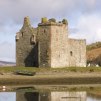 |
| MacLellan's Castle, Kirkudbright, Dumfries and Galloway Owned by: Historic Scotland Well preserved remains of late 16th century noble residence. Standing at the top of the main street in Kirkcudbright, this castellated town house was built in the 1570s on the site of the medieval Greyfriars convent. Founded in 1449 by James II, Greyfriars was dissolved in the Reformation. The architecture of the castle demonstrates how design had evolved from the heavily defended tower to a new, more domestic house. Restricted summer opening times and entrance charges apply. |
|
| Mey Castle, Thurso, Caithness Owned by: The Queen Elizabeth Castle of Mey Trust Former home of the late HM Queen Elizabeth, The Queen Mother. Built by the Earl of Caithness between 1566 and 1572, originally as a three storey tower house. Mey is the former home of the late HM Queen Elizabeth, The Queen Mother, who bought what was then Barrogill Castle in 1952 while mourning the death of her husband, King George VI. Having acquired the most northerly inhabited castle on the British mainland, The Queen Mother spent the next 50 years renovating and restoring it. Restricted opening times and entrance charges apply to both the castle and garden. |
|
| Morton Castle, Carronbridge, Dumfries and Galloway Owned by: Historic Scotland Remains of late 13th century hall house. Standing on a triangular headland with Morton Loch on two sides, the remains of an earlier 13th century castle were rebuilt in the 15th century as an impressive hall-house. Morton was sacked by James VI in 1588 in his efforts to stem the power of the Douglases. Only partly reoccupied after this, the castle had been abandoned by the start of the 18th century. Usually free and open access at any reasonable time. |
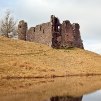 |
| Muness Castle, Island of Unst, Shetland Owned by: Historic Scotland This late 16th century tower house is the northernmost castle in the British Isles. Muness was built by Laurence Bruce, who according to records of the day was a particularly nasty and corrupt piece of work. In 1627 French raiders attacked and burned the castle; although repaired, it appears to have been abandoned by the end of the century. Usually free and open access at any reasonable time. |
|
| Neidpath Castle, Peebles, Borders Owned by: English Heritage Originally built by Sir William de Haya in the late 14th century, the castle was remodelled and added to during the 1660s. Today Neidpath is an intact tall tower house with rounded corners, battlements and a pit dungeon. The castle is not open to the public, except by arrangement. |
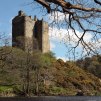 |
| Newark Castle, Port Glasgow, Port Glasgow, Strathclyde Owned by: Historic Scotland Well preserved 15th century castle. Standing on the south shore of the River Clyde, as far upriver as was navigable for seagoing ships, the castle was built in 1478 by George Maxwell. The original design included a tower house within a walled enclosure. In the late 16th century the castle was inherited by Sir Patrick Maxwell, who remodelled the building constructing a three storey Renaissance mansion. A powerful friend of King James VI of Scotland, Sir Patrick was notorious for murdering two members of a rival family and beating his wife of 44 years, mother of his 16 children. Restricted summer opening times and entrance charges apply. |
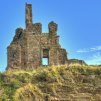 |
| Noltland Castle, Pierowall, Isle of Westray, Orkney Owned by: Historic Scotland Remains of 16th century tower house. Built by Gilbert Balfour between 1560 and 1573, the castle comprised a rectangular main block with towers at opposite corners. Balfour was Master of the Royal Household to Mary, Queen of Scots. In 1650 during the Wars of the Three Kingdoms, Royalist officers occupied the castle after their defeat at the Battle of Carbisdale. Later local Covenanters captured and burned the castle. By 1881 it was described as a ruin. Usually free and open access at any reasonable time. |
|
| Orchardton Tower, Castle Douglas, Dumfries and Galloway Owned by: Historic Scotland This well preserved 15th century building is remarkable by being the only cylindrical tower house in Scotland. Usually free and open access at any reasonable time. |
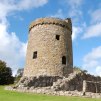 |
| Ormacleit Castle, South Uist, Western Isles Owned by: Scheduled Ancient Monument More of a fortified manor than a castle, building began around 1701 by Allan MacDonald, the chief of Clan Ranald, on the site of an earlier 16th century house. French architects were brought over to supervise the work, and by 1707 Ormacleit was occupied. Shortly after it was finished, on the eve of the Battle of Sheriffmuir in November 1715, the castle burned down. MacDonald died in the ensuing battle and the castle was never rebuilt, as the Clan Ranald seat moved to Nunton on nearby Benbecula. Standing on a private farm, the castle is not open to the public although it is visible from the road. |
|
| Peel Ring Of Lumphanan, Lumphanan, Aberdeenshire, Grampian Owned by: Historic Scotland This present earthwork dates from the 13th century date and was the site of a fortified residence of the Durward family. The peel consists of a motte or mound, surrounded by two concentric ditches and a bank. An earlier motte on this site is thought to have existed when the Battle of Lumphanan was fought in 1057, between King Macbeth and the future King Malcolm III. Macbeth's Stone, upon which the king is said to have been beheaded, is located nearby. Usually free and open access at any reasonable time. |
|
| Pitsligo Castle, Rosehearty, Aberdeenshire, Grampian Owned by: Pitsligo Castle Trust Built around 1424 by the Fraser family of Philorth, the ownership of the tower later passed to the Forbes family of Druminnor who extended the castle to its current layout. In 1745, the castle suffered after the Battle of Culloden and was pillaged by Hanoverian troops. By the end of the 19th century it was in ruin. Usually free and open access at any reasonable time. |
|
| Portencross Castle, Ayrshire Owned by: Friends of Portencross Castle Remains of 14th century castle. Started around 1360, Portencross was the seat of the Boyds of Kilmarnock. The Boyds had been gifted the lands on which the castle stands by King Robert I as a reward for their support at the Battle of Bannockburn in 1314. The castle was occupied until 1739, when a particularly nasty storm blew the roof off. Usually free and open access at any reasonable time during summer months. |
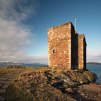 |
| Ravenscraig Castle, Kirkcaldy, Fife Owned by: Historic Scotland Remains of 16th century royal castle. Ordered by King James II in 1460, the castle was built as a home for his wife, Mary of Guelders. The castle is considered to be one of the first, if not the first, in Scotland to be built to provide defence from cannon fire. The castle design consists of two round towers linked by a cross range, the west tower provided the living quarters for James' widow Queen Mary, who lived there until her death in 1463. Ironically, James had been killed in a tragic accident when a loaded cannon exploded at the Capture of Roxburgh Castle only months after work on Ravenscraig had begun. Free but limited access at any reasonable time. |
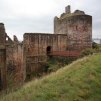 |
| Rothesay Castle, Rothesay, Isle of Bute, Strathclyde Owned by: Historic Scotland Very well preserved early medieval castle. Although earlier fortifications existed on the site, the current castle was built to an unusual circular design at the beginning of the 13th century. The castle comprises a huge curtain wall with four round towers, all surrounded by a substantial moat. Set on the Isle of Bute in a busy stretch of Viking controlled waters, the castle survived several Norse attacks to become a royal residence of the Stewart Kings of Scotland. Restricted opening times and entrance charges apply. |
|
| Rowallan Castle, Kilmaurs, Strathclyde Owned by: Historic Scotland This grand Renaissance mansion is based around a late 13th century two-storey tower house. Extended over the centuries that followed, it was the home of the influential Muir family who counted writers, historians, and composers amongst their number; the earliest lute music to survive in Scotland was written at Rowallan. Access only by pre-booked tour and entrance charges apply. |
|
| Scalloway Castle, Scalloway, Shetland Owned by: Historic Scotland This castellated mansion was built in 1600 by the infamous Patrick Stewart, Earl of Orkney. Built to tighten his grip on Shetland, Earl Patrick continued the Stewart family traditions of corruption and brutality. Free access at any reasonable time. |
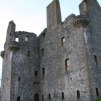 |
| Skipness Castle, Skipness, Kintyre, Argyll and Bute Owned by: Historic Scotland Built in the early 13th century by the Clan MacSween, later fortifications were added in the centuries that followed. In 1494, the castle was garrisoned with royal troops during King James IV's suppression of the Isles. During the Wars of the Three Kingdoms in 1646, the castle was besieged; it was abandoned by the end of the century. Free access at any reasonable time. |
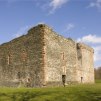 |
| Slains Castle, Aberdeenshire Owned by: Slains Partnership Remains of 16th century tower house. Set on a cliff-top overlooking the North Sea, this 16th century tower house was built by Francis Hay, 9th Earl of Erroll. Also known as New Slains Castle to distinguish it from nearby Old Slains Castle which was destroyed on the orders of James VI in 1594, following a localised Catholic rebellion. Seat of the powerful Clan Hay, the castle was extensively remodelled in a Scots Baronial style in the mid-1830s. Sold in 1913 by the 20th Earl of Erroll, the now roofless shell awaits restoration. Usually free and open access at any reasonable time during summer months. |
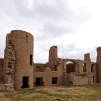 |
| Sorbie Tower, Sorbie, Dumfries and Galloway Owned by: Clan Hannay Built in the late sixteenth century, this traditional Scottish fortified tower house is the ancient seat of the Clan Hannay. By 1748 the tower had become became ruinous; it remains to second floor level, although unusual for such a building there is no wall-walk or parapet atop. Free access at any reasonable time. |
|
| St Andrews Castle, St Andrews, Fife Owned by: Historic Scotland Remains of 13th century castle of the archbishops of St Andrews. Built around the late 1100s, St Andrews served as the ecclesiastical centre of Scotland in the years before the Protestant Reformation. During the Wars of Scottish Independence, the castle was destroyed and rebuilt several times as it changed hands between the Scots and the English. Most of what can be seen today dates from a rebuild completed around 1400 by Bishop Walter. Restricted opening times and entrance charges apply. |
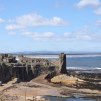 |
| Stalker Castle, Argyll Owned by: Allward family Largely restored 15th century tower house. Built on the site of an earlier fortification, the current Castle Stalker was erected by Sir John Stewart, Lord of Lorn, around the mid-1400s. The four storey tower house, or keep, occupies a picturesque setting on a small tidal island in Loch Laich. Lost in a drunken wager to the Clan Campbell in 1620, the Campbells finally abandoned the castle around 1840. Castle Stalker again found fame appearing in the 1975 film Monty Python and the Holy Grail. The castle is now privately owned with a limited number of tours operated during summer months. |
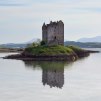 |
| Stirling Castle, Stirling, Stirlingshire Owned by: Historic Scotland One of the largest and most important castles in Scotland, it is surrounded on three sides by steep cliffs and guards what was the farthest downstream crossing of the River Forth. The castle has survived at least eight sieges and several Scottish kings and queens have been crowned at Stirling, including Mary, Queen of Scots. Most of the current castle buildings date from the 15th and 16th centuries. Restricted opening times and entrance charges apply. |
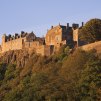 |
| Tantallon Castle, North Berwick, Lothian Owned by: Historic Scotland Semi-ruined mid-14th century fortress. Built in the mid-14th century by William Douglas, it remained the seat of the Douglas Earls of Angus for most of its history. Besieged by King James IV in 1491, and then again by James V in 1528, Tantallon also saw action in the First Bishops' War in 1639. Following a twelve day bombardment with cannon, the castle was left in ruins during Oliver Cromwell's invasion of Scotland in 1651: it was never repaired or inhabited afterward. Restricted opening times and entrance charges apply. |
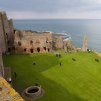 |
| Threave Castle, Castle Douglas, Dumfries and Galloway Owned by: Historic Scotland Remains of large 14th century tower. Built by Archibald the Grim, Lord of Galloway in the 1370s on an island in the River Dee, Threave became the stronghold of the Black Douglases. William Douglas, 8th Earl of Douglas, began a series of improvements to the castle's defences in 1447, and in 1455. Threave withstood a two month siege before the garrison, bribed and promised safe conduct, surrendered. Restricted opening times and entrance charges apply. |
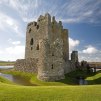 |
| Tolquhon Castle, Pitmedden, Aberdeenshire, Grampian Owned by: Historic Scotland Remains of 15th century tower house. Built by William Forbes, 7th Laird of Tolquhon between 1584 and 1589, adding to an earlier tower house which is still stands, the castle features a highly ornamented gatehouse. Tolquhon is one of the most picturesque castles in the Grampian countryside. Restricted opening times and entrance charges apply. |
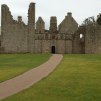 |
| Urquhart Castle, Dumnadrochit, Highlands Owned by: Historic Scotland Though built on the site of an early medieval fortress, the present ruins overlooking Loch Ness date from the 13th to the 16th centuries. Urquhart played a role in the Wars of Scottish Independence in the 14th century and was subsequently held as a royal castle. Largely abandoned by the middle of the 17th century, the castle was partially destroyed in 1692 to prevent its use by Jacobite forces, and subsequently fell into disrepair. Restricted opening times and entrance charges apply. |
 |
Highland Tours Featuring Castles
Have we missed something?
Although we've tried our hardest to list every castle in Scotland, we're almost positive that a few have slipped through our net... that's where you come in!
If you've noticed a site that we've missed, please help us out by filling in the form below. If you include your name we'll be sure to credit you on the website.
